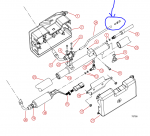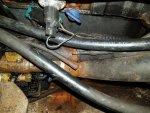I have been trying to resolve a fuel starvation issue with our boat. It is powered by a 2000 7.4l mpi (L29) with the "peanut ports". I have replaced and reclamped the fuel supply line from the tank to the fuel filter/separator, which had a small leak. That seemed to fix the issue until we took an extended cruise and it sputtered after an hour on plane. Once the fuel caught up I could get back up on plane.
I have retraced the fuel lines and noticed the vacuum line was unhooked. Picture and diagram attached. Could this explain why the fuel supply does not keep up while at cruising speed? It looks like it have been unattached for a while. I test drove the boat last night after I re-attached the line (very difficult to reach) and it seems to work fine, but admittedly I may not have run it long enough. This winter I plan to pull the pickup in the tanks to clean it.

I have retraced the fuel lines and noticed the vacuum line was unhooked. Picture and diagram attached. Could this explain why the fuel supply does not keep up while at cruising speed? It looks like it have been unattached for a while. I test drove the boat last night after I re-attached the line (very difficult to reach) and it seems to work fine, but admittedly I may not have run it long enough. This winter I plan to pull the pickup in the tanks to clean it.






















